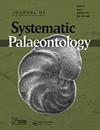A new cyprinid from the Oligocene of Qaidam Basin, north-eastern Tibetan plateau, and its implications
IF 2.2
2区 地球科学
Q3 EVOLUTIONARY BIOLOGY
引用次数: 6
Abstract
The Qaidam Basin, lying in the north-eastern Tibetan Plateau, China, is key to understanding the Cenozoic climatic and biological changes that have occurred on the plateau; however, information from a palaeontological perspective on this Palaeogene basin is scant. Recently, fossil cyprinids were found in the middle portion of the Shangganchaigou Formation (= Upper Ganchaigou Formation; Oligocene) in the north-western Qaidam Basin. These share many osteological characters with barbines and ‘morphologically primitive clade schizothoracines’ (= primitive schizothoracines; i.e. Schizothorax and Aspiorhynchus), and they closely resemble the latter in the size and shape of the scales: body scales are small and oval; the number of lateral line scales exceeds 100; and the long-oval scales from the pre-anal region are very similar to the ‘anal scales’, which are unique to schizothoracines. Compared with another fossil fish, Paleoschizothorax qaidamensis, from the same formation, the major differences are: (1) the posterior part of the entopterygoid in the new material is normal and not expanded while that of P. qaidamensis is obviously expanded; and (2) the premaxilla process of maxilla is well developed in P. qaidamensis but weak in the new specimens. Therefore, they are described as a new species of the fossil genus Paleoschizothorax (subfamily Schizothoracinae): Paleoschizothorax diluculum sp. nov. A phylogenetic analysis, which included 13 extant genera and three fossil forms of barbines and schizothoracines and 70 morphological characters, also supports the close relationship between P. diluculum and primitive schizothoracines. A preliminary correlation analysis suggests that the degree of reduction of body scale size is negatively correlated with habitat mean temperatures among most Chinese cyprinids. Moreover, we speculate that the ‘primitive schizothoracines’ likely originated in the north-eastern–central Tibetan Plateau based on the fossil records and molecular phylogeny of the extant taxa. http://zoobank.org/urn:lsid:zoobank.org:pub:C461C7C0-9BAB-44DD-8DEE-0B5BB03D6479青藏高原东北部柴达木盆地渐新世一种新的鲤科动物及其意义
柴达木盆地位于中国青藏高原东北部,是了解高原新生代气候和生物变化的关键;然而,从古生物学的角度来看,关于这个古近系盆地的信息很少。近年来,在柴盆地西北部的上干柴沟组(上甘柴沟组;渐新世)中部发现了柏树化石。它们与巴比妥类和“形态原始分支裂胸动物”(=原始裂胸动物;即裂胸动物和Aspiorhynchus)有许多相同的骨学特征,并且在鳞片的大小和形状上与后者非常相似:身体鳞片小而椭圆形;横向线刻度的数量超过100;肛门前区域的长椭圆形鳞片与裂胸动物特有的“肛门鳞片”非常相似。与来自同一地层的另一种鱼类化石——卡氏古裂胸鱼相比,主要区别在于:(1)新材料中的内翼后部正常,没有扩张,而卡氏P.的内翼明显扩张;(2)卡氏疟原虫上颌骨前突发育良好,但在新标本中发育较弱。因此,它们被描述为古裂胸蛙化石属(裂胸蛙亚科)的一个新种:古裂胸蛛Diululum sp.nov。系统发育分析包括13个现存属和三种芭比类和裂胸蛙的化石形式以及70个形态特征,也支持了Diulum与原始裂胸蛙之间的密切关系。初步相关分析表明,大多数中国鲤鱼的体尺缩小程度与栖息地平均温度呈负相关。此外,根据现存分类群的化石记录和分子系统发育,我们推测“原始裂胸类”可能起源于青藏高原东北部-中部。http://zoobank.org/urn:lsid:zoobank.org:pub:C461C7C0-9BAB-44DD-8DEE-0B5BB03D6479
本文章由计算机程序翻译,如有差异,请以英文原文为准。
求助全文
约1分钟内获得全文
求助全文
来源期刊
CiteScore
5.30
自引率
7.70%
发文量
31
审稿时长
>12 weeks
期刊介绍:
The Journal of Systematic Palaeontology publishes papers that provide novel and impactful results in phylogenetics and systematics and that use these results in ways that significantly advance rigorous analyses of palaeogeography, palaeobiology, functional morphology, palaeoecology or biostratigraphy. Papers dealing with theoretical issues or molecular phylogenetics are also considered if they are of relevance to palaeo-systematists. Contributions that include substantial anatomical descriptions, descriptions of new taxa or taxonomic revisions are welcome, but must also include a substantial systematics component, such as a new phylogeny or a revised higher-level classification. Papers dealing primarily with alpha-taxonomic descriptions, the presentation of new faunal/floristic records or minor revisions to species- or genus-level classifications do not fall within the remit of the journal.

 求助内容:
求助内容: 应助结果提醒方式:
应助结果提醒方式:


